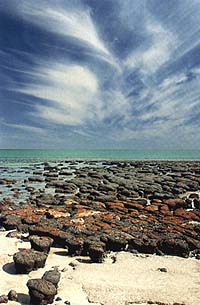![]()
![]()
Geologic events that alter environments change the
course of biologic history. The formation and subsequent breakup
of the super continent Pangea for example affected the diversity of life
immensely. The evolution of life conversely affects the planet it
inhabits. The evolution of photosynthetic organisms is a primary
example of this by releasing oxygen into the earth's atmosphere, in turn
altering the earth's atmosphere. Until the last few decades the absence
of the precambrian fossil record puzzled palaeontologists and geologist
until the discovery of microscopic fossils of Prokaryotes.
Prokaryotes originated within a few hundred million
years after Earth's crust cooled and solidified. There have been
mineral found that crystallized approximately 4.1 Billion years ago (BA)  and
sedimentary rocks that date to 3.8 BA, the fossil record does not date
back that far. However, Prokaryote fossils have been discovered in
southern Africa that date to 3.4 BA in the Chert of the Fig Tree Formation.
Evidence of even more ancient life has also been found in rocks that are
called Stromatolites. Stromatolites are organo-sedimentary structures
produced by sediment trapping, binding and/or precipitation as a
result of the growth and metabolic activity of micro-organisms, principally
cyanobacteria (Prokaryotes). They form banded domes of sediment,
and are very similar to layer mats constructed by cyanobacteria alive today
in salt marshes (the present is the key to the past). The
layers are created by sediments that stick to the jellylike coats of motile
microbes, that continually migrate out of one layer of sediment and for
a new one above, producing a banded pattern.
and
sedimentary rocks that date to 3.8 BA, the fossil record does not date
back that far. However, Prokaryote fossils have been discovered in
southern Africa that date to 3.4 BA in the Chert of the Fig Tree Formation.
Evidence of even more ancient life has also been found in rocks that are
called Stromatolites. Stromatolites are organo-sedimentary structures
produced by sediment trapping, binding and/or precipitation as a
result of the growth and metabolic activity of micro-organisms, principally
cyanobacteria (Prokaryotes). They form banded domes of sediment,
and are very similar to layer mats constructed by cyanobacteria alive today
in salt marshes (the present is the key to the past). The
layers are created by sediments that stick to the jellylike coats of motile
microbes, that continually migrate out of one layer of sediment and for
a new one above, producing a banded pattern.
Recent stromatolites at Hamelin Pool, Aus